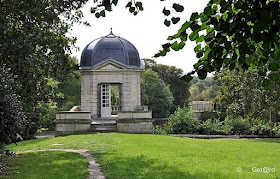Saturday, May 26, 2012
Pavillon d'amour, Neuville-sur-Oise
One of the wonderful things about the Ile-de-France, the region surrounding Paris, is the density of ancient construction and—once beyond the grasp of the hodge-podge of rather depressing suburbs—the beauty and largely intact rural character of the land known as "the great crown." Neuville-sur-Oise is one of these ancient villages, grown around a feudal château, and its pride is one of the most perfect examples of the pavillon d'amour form, so perfect in fact that it negates this hoary architectural cliché of the clichéd age of la douceur de vivre. (Above, our watercolor portrait.)
The octagonally planned pavilion is a true belvedere, magisterially sited on a projecting cut-stone terrace overlooking the river Oise, the massive, canted and chamfered basement suggesting a ship's prow. The building is rather sedate until one considers the voluptuously over-scaled slate roof, another suggestive form evoking the voluminous, curving panniers of an ancien régime court dress.
The property had a brush with fame in the late 18th century, when in 1775 it was purchased by Count Mercy-Argenteau, the Austrian ambassador to the court of France and confidant and advisor to Marie-Antoinette. Though no documentation exists, it is believed that the pavilion was built earlier, in the mid 17th century, as it literally exudes the quiet sophistication of France's Augustinian Age.
The count brought artisans who had worked on the queen's own apartments at Versailles to embellish the château with fine furniture and exquisitely carved boiseries, and the mistress who undoubtedly inspired the pavilion's appellation was Rosalie Levasseur, who was—in yet another 18th-century cliché—a beautiful opera singer.
The pavilion was restored recently and has become the town's symbol and pride but the Château de Neuville has unfortunately not fared as well and is, inexplicably, a gaping wreck. It is always a mystery how such historic properties, relatively near Paris, can still today remain abandoned and in complete decrepitude.
I always imagine interminable lawsuits by feuding heirs stretching over generations and worthy of Bleak House. At least I prefer this to the idea of the owners allowing the property to rot beyond repair so that the land can be redeveloped, which is most often the case, as French landmark laws have no legal mechanism to force maintenance of most listed properties. However, in truth the still-handsome shell is thankfully slated to be saved and find new life as a retirement home.






The pavilion ia magnificent. I want one! It is unfortunate that history has not been as kind to the chateau itself.
ReplyDelete